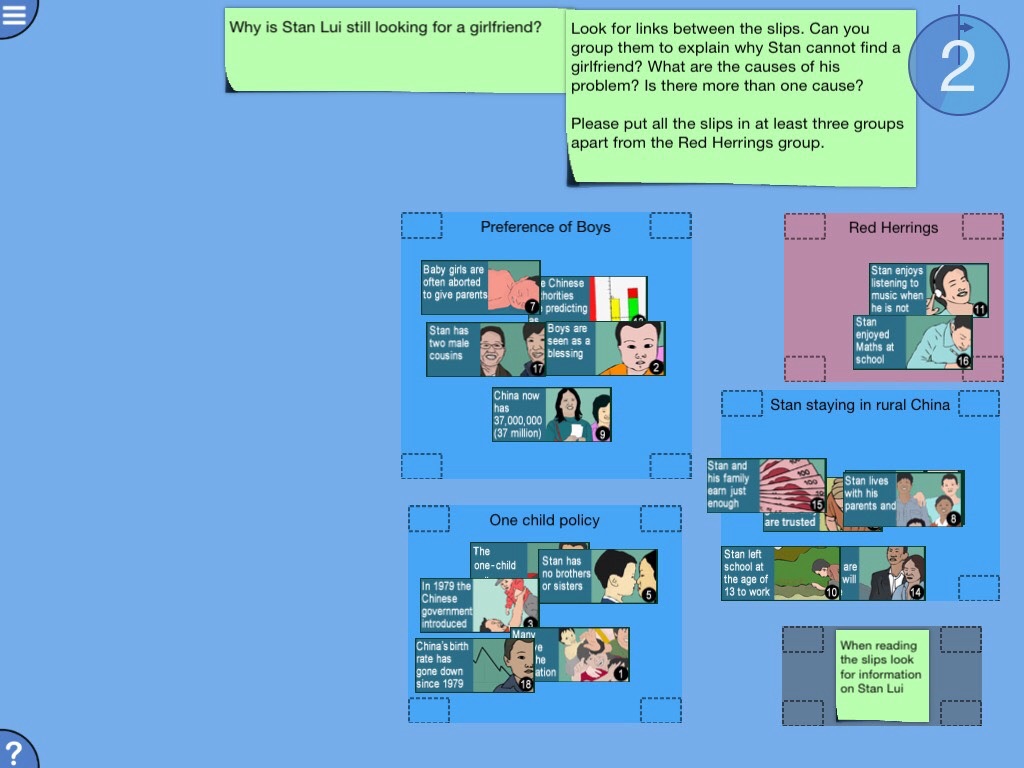
Digital Mysteries: China Population is a unique app in allowing pairs to work simultaneously on one iPad with a task designed to encourage discussion and higher-level thinking around the KS4 National Geography Curriculum.
Users are given illustrated slips of information on the topic which they read, organise into groups and then sequence to represent their thought pattern of how they came to their answer. This is in response to the open-ended question ‘Why is Stan Lui still looking for a girlfriend?’ A PDF report is generated which can be printed off or shared as a record of learning. Students can also go through the Reflection Stage in which they can playback the process and reflect on their ideas.
This resource is intended to help students to look at and understand the effects of China’s one-child policy, which was introduced in 1979. It surrounds Stan Lui, a 27 year old man and agricultural worker who lives with his elderly family in rural Hainan Island in China. Stan has worked on the farm since he was 13 and is an only child with responsibility for the farm and his family. Through Stan’s situation, along with general facts on the topic, the mystery considers the positive and negative effects of the policy as well as Stan’s own situation.
Who is Digital Mysteries: China Population for?
This app works well with those aged 14-16 (KS4). By having three difficulty levels, it supports differentiation in class and can be suited to varying abilities/levels of knowledge. As the difficulty level goes up, more slips are added (e.g. with abstract information).
What is different about Digital Mysteries?
• Truly collaborative: It is unique in that more than one student can interact with it at once
• Curriculum-mapped: Tasks are directly mapped to the National Curriculum for England
• Record of learning: Students can interact and have fun with exciting technology then generate a printable PDF report of their session which shows what they’ve done
• Retention: Working with information slips from two different perspectives (grouping, then fitting them into a sequence) ensures students remember more
• Higher-level thinking: The multiple discussion points, combined with the task’s open-ended nature, leads to students developing these skills
• Reflection: Sessions are recorded so students can playback and discuss what they’ve done, emphasising the importance of the process as well as the outcome
• Engagement: Mysteries split bulks of information into short snippets which makes it more digestible, plus working with peers leads to higher engagement levels
• Research: We’ve done years of academic research on how to make the most of touch screens for learning
What does a mystery consist of?
• Illustrated slips of information: Including facts on the topic alongside story-based snippets about a particular character and their experiences
• Open question: To maximise the potential of collaboration, discussion, and expression of ideas, the nature of the task is usually open ended
• Extras: Most tasks come with personalised hints for those who need them. E.g. suggestions for grouping or sequencing their slips
• Description: This gives teachers the information they need to plan their session including the curriculum point each task links to, the advised age range and possible learning outcomes
How can I try other mysteries?
At the bottom of the app details tab, tap ‘Developer Apps’ to view our current range. Many more for KS1-4 are available, including more in Geography, with others being for English, History and Computing.



